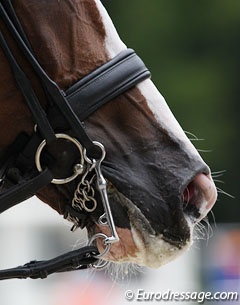
A study by researchers Dr. Jo Hockenhull and Dr. Emma Creighton of the School of Veterinary Sciences at the University of Bristol revealed that riding equipment is often used as quick-fix for behavioural problems and training issues.
The interaction between horse and rider is mediated by the use of tack and other equipment. The plethora of equipment available for the ridden horse raises the question of how riders select the most appropriate for their horse, their skill level and the work they undertake.
Concerns have been raised that riding equipment may be used as a quick-fix to suppress behavioural symptoms of an underlying training issue rather than addressing the cause of the problem through re-training. An open-ended question was included in a horse-level internet survey that covered equipment and training practices used by UK leisure horse owners. Respondents were asked to explain why they used the equipment they did on their horse.
Of the 1324 survey respondents, 1036 completed the question. The responses were coded into broad themes according to content. A multiple response coding strategy was used to allow each response to be coded under multiple themes. Coding was conducted using NVivo 7 software for qualitative data analysis. Twenty-six key themes were identified.
The most commonly cited were that the equipment was chosen because the horse goes well in it (26% N=269) and to help the rider to control the horse, either as a necessity or as a precautionary measure (17% N=173). Some respondents stated that certain equipment was only required on specific occasions, e.g. when competing or hunting, rather than every time the horse was ridden (15% N=158).
Equipment was used to tackle a particular evasion by the horse (11% N=118) or as a training aid (11% N=115). Some riders reported always using certain equipment as a personal preference or because it came with their horse (7% N=72); others reported that specific items of equipment, e.g. breastplates and running martingales, were used primarily to stabilise and reassure the rider rather than through a need directly arising from the horse’s behaviour (4% N=42).
The choice of equipment for the ridden horse has significant welfare implications. Many of the items available to riders are potentially aversive, especially if used incorrectly. There is also a risk that riders may be tempted to use increasingly severe gadgets to address issues, such as a lack of control that would be better resolved through re-training.
The findings of this study contribute to our understanding of what motivates a rider’s choice of riding equipment for their horse, enabling areas requiring further investigation, and improved rider education, to be identified. The reliance on equipment to control the horse is a key area to address in future studies.
-- 2011 ISES Conference Abstract
Related Links
Whipping of Race Horses is Influenced by Jockey's Experience
Horses and Abnormal Behaviour Investigated in Three Counties in Sweden
The Effect of Tryptophan Products on Stressful Horses